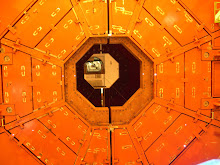 Alan Gillis Reports Nine months after the 8.9 earthquake and tsunami, the Japanese Government claims that the 3 damaged nuclear reactors at Fukushima Daiichi are in cold shutdown conditions. Yes, if you add "conditions" which they did. At best with all the jerry-rigging to cool down the melted reactor cores and melted spent fuel pond at Reactor 4, using a mile of rubber hose to patch in new pumps, also add Temporary to cold shutdown conditions and 40 years to dismantle the industrial carnage in the Japanese government's new plan. That is if all goes well and new technologies are developed to safely remove melted cores and rods and dispose of them somehow somewhere.
Alan Gillis Reports Nine months after the 8.9 earthquake and tsunami, the Japanese Government claims that the 3 damaged nuclear reactors at Fukushima Daiichi are in cold shutdown conditions. Yes, if you add "conditions" which they did. At best with all the jerry-rigging to cool down the melted reactor cores and melted spent fuel pond at Reactor 4, using a mile of rubber hose to patch in new pumps, also add Temporary to cold shutdown conditions and 40 years to dismantle the industrial carnage in the Japanese government's new plan. That is if all goes well and new technologies are developed to safely remove melted cores and rods and dispose of them somehow somewhere.At Chernobyl the solution was to cap the disaster with concrete. There was no way to cool the single exploded reactor with its mangled fuel rods scattered in a heap on the floor. With the aging sarcophagus steadily rotting, there is now a multi-billion dollar project underway to dismantle the cap and destroyed reactor complex (caused by a steam explosion during a safety test in 1986) and cover what's left with a giant containment building.
The China Syndrome
With 4 nuclear nightmare meltdowns at Daiichi, 3 reactors and 1 cooling pond, the Japanese situation was beyond critical. What could happen was far worse than what did happen at Chernobyl. Though with reactor vessels still holding it was thought or at least their concrete casings, there was a chance for a safe cooldown. It was a desperate gambit, a bet with a nuclear devil with a potential of more than 4 times the fallout of Chernobyl if the Japanese lost control of Daiichi. In the end they almost did loose control of Reactor 1 according to The Wall Street Journal, December 1. The 100 tons of uranium metal that comprised the core did liquefy and burned through the stainless steel vessel and 3/4 the way through the concrete containment, on the way to a China Syndrome. How did that happen?

Shutdown Cooling System Reactor 1 (Operator Error: TEPCO Report)
The problem is no one knows if the temporary Cold Shutdown Conditions will hold while extraction of somewhere around a 1,000 tons of superhot nuclear fuel goes on for 25 years. The new 40 year plan appears to avoid the need for a new and permanent cooldown system while work goes on. "Maintain stable reactor cooling" says the plan. Stockpile duct tape, hai.
Fukushima 40 Year Cleanup Or More Cheapo-Screamo
The first target is the spent fuel rods stored at 4 reactors starting with the more dangerous melted and damaged rods from the pool at Reactor 4. That extraction of hundreds of tons of spent fuel should start in 2 years and would take around 10 years to remove. Meanwhile reactor cores would be examined and properly flooded with heavy water before workers start the even more difficult and dangerous extraction of melted cores to take another 10-15 years, then another 10 years to dismantle and decontaminate the site. That's 40 long years if all goes well.
And what do you do about general Daiichi contamination and current radiation leaks so workers can safely extract the hot uranium? A makeshift shed for Reactor 1 now in place, but no secure containment for the old exploded reactor buildings that are dangerously radioactive with flooded basements too of radioactive water, 90,000 tons in all onsite, including some in tanks above ground.
Use robots, build robots first, design robots before start, checkout American MIT in lunch teams for exploratory session, no try unJapanese solution first, bake many meetings, try remote Honda Prius fly in 5000 for gang-bang enemy reactors.
Then like Chernobyl, shouldn't Fukushima Daiichi be fully shielded by a vast containment building over the entire site in case of other accidents like cooldown failure or another tsunami? At least stop any radiation release. It might be the permanent solution after all if there's major trouble with the Plan. In the end what do you do with all the nuclear waste?
Bury it somewhere else of course, though more safely. That's possible if you could ship it all to France (Japanese problem solved) where the French have the expertise in reprocessing and permanent storage. Or of course bury it at Daiichi and go Cheapo-Screamo to save a few billion bucks. Cleanup number 2 around Daiichi is way more gigantic, over 1500 square miles of primary contamination and thousands more of secondary, and could sink Japan too as every last Yen falls into the bottomless Fukushima money pit.
Not Saving Fukushima
It wasn't thanks to a mature nuclear industry (in surprise mode) or a wise government that had plans and answers. There was however some serious (don't panic the public) lowballing of the disaster from the authorities including low estimates on just about everything from reactor damage to radiation released and food safety. Another nail after nail in the coffin of public trust, we're so used to on this side of the Pacific, though shockingly new in a modern Japan that thought it had recovered from Samurai movies and feudalism. Suddenly safe friendly nuclear is only safe if you lowball the risks and PR the percentages to death.
Fukushima was the  devastating wakeup call for Japan.
devastating wakeup call for Japan.
The national psyche where paternalism and conformity were the usual pillars of success took a hit. After the earthquake and tsunami the third nuclear shock was too great to be a game-changer. The public reaction was eerily quiet. The Japanese did not take to the streets to stop nuclear or call for the collapse of the government, apart from some mild demonstrations in Tokyo. Did not even remind the government that it failed to protect them as is the primary function of any government and why powerful central governments came into being in the first place. After all private industry can do most everything else including get us into trouble. Even TEPCO the utility in charge was not raked over the coals.
What did happen to Japan was a kind of national paralysis. First the great tsunami from nature and then on its heels the greater man-made nuclear threat for a generation. The Japanese public could only wander through the tragedies we watched on TV. In other countries there might have been panic and riots. In Japan the nuclear disaster and menace to the future didn't need a voice of thunder. The disaster seemed to be everywhere as high as the sky, as deep as the water.
Still who is to blame? What needs to change? Can Japan go forward if it re-builds on the sands of the past? Has the world gone forward after the financial meltdown? Still melting. You can blame the banks for the global financial meltdown as Occupy Wall Street has done and you can blame TEPCO for the meltdowns of Daiichi, but governments create the conditions for exploitation and disaster or safeguard the land and the people. Governments must change and that means the people who make the decisions. The easiest way? Make them liable for stupid mistakes like the rest of us. In most any country politicians walk away from their jobs with pensions, deserved or not. Shrugging off stupid policy or dumb do nothing that can cost us Billions is part of the political game: Public Service, win some loose some. Let the next guy fix the mess and let the public pay.
A Ray Of Hope Or Back To Square One
At least the Japanese government did respond by shutting down other nuclear plants at risk of similar failures pending new safety reviews and went as far as suggesting that nuclear power would be phased out within 40 years. Other governments took notice of nuclear reality and international protests and followed suit. At least in Germany, the waffling over nuclear is at an end. Other smaller nuclear powers like Italy might call it quits too, but the big players like the US, Russia, China and France are still in the nuclear game at least until the next accident.
After the initial soul-searching the picture that is now emerging in Japan is nuclear plants coming back online with some committee rehashing of alternative energy sources like wind and solar, some promises of funding for more green energy.
In the East they say The Journey of a Thousand Miles Begins with One Step. In our non-Confucian age we say Too Little Too Late. Since Hiroshima and Nagasaki, hasn't Japan and the world been on the wrong road to power? Who built the bombs that can burn the Cauldron of the World? Who subsidized a nuclear power industry that threatens the well-being of every plant, animal and human on the planet? A thousand corporations or a handful of governments?

Bring On The Experts
Even now the experts still don't know the condition of damaged cores and containment. As late as November there were reports of more nuclear fission products detected meaning more nuclear fission. According to the Plan the reactor vessels and concrete are assumed to be stable, but will they deteriorate further, maybe breaching during the very long cleanup? It depends not only on continuing cooling but the corrosion of the concrete. A recent experiment at MIT suggests that concrete can corrode in the presence of seawater and uranium. Emergency seawater injection was already used as a stopgap coolant with boric acid. Is it still inside the reactors or has it been replaced with the usual safer heavy water (not available in drug stores) or purified water at least? Dasani, hai.
Saving Fukushima
When it came down to saving technological Japan from itself, it was seawater and fire trucks and firemen and the Fukushima 50 and the workers that followed, the brave few, that stood alone with a little luck behind them battling forces that could have destroyed Fukushima.
If 'cold shutdown' holds at Daiichi (the winter will be the next stress test on the makeshift cooldown system) there's a better future for Fukushima, though there are no guarantees. Not yet for the 88,000 still displaced from their homes and farms in the 12 mile No Go Zone and the larger 20 mile exclusion zone around Daiichi. Considering the scope of the damage, both from tsunami and nuclear contamination, at best there's little hope of a return to what residents had. A promise of a large scale Fukushima cleanup starting next Spring that could allow some into the outer zone, but how do the Japanaese decontaminate thousands of square miles and thousands of buildings exposed to about the equivalent of 60% of the fallout released from Chernobyl?
The reality so far is an abandoned Fukushima in cold shutdown and slow decay with police checkpoints about the only safety system in place. For something to do while waiting they can always read the TEPCO Report, the Government Plan and the new interim 500 plus page brick of a Government Report suitable for throwing, just out. Enough fallout there to kill every hope for no sequel to Rise of the Planet of the Apes. The usual disaster B movie stuff where you want to scream in Japanese: Everybody 'ron' 'ron' 'ron'. Stupid Daiichi, lucky monkey SOB!
The Probable Future When Money Makes Policy
Is the Japanese government like most governments promising what it cannot deliver? If you look at the EPA's long list of old nuclear sites in the US needing decontamination at millions of dollars an acre, if you look at the vast Chernobyl hinterland how do you scoop up billions of tons of contaminated topsoil and where do you put it? You don't. Of course you can study how to do it. Remove a little cesium contaminated topsoil, plant some new rice, wait. Burn the rice and measure radioactivity left, as is being done in a few test zones called Model Rehabilitation Projects. Or tag wild monkeys with dosimeters to see how much and how dangerous the radiation is. Never mind the radioactive groundwater contamination which keeps on spreading and is impossible to stop. Gone for awhile like the hypothetical badass rapper $40Million. Back as $40Billion, on your back and in your fn water tap.
From lessons learned, it is highly unlikely that the Japanese government can do more for Fukushima than a superficial cleanup. At present the government's plan is superficial. The first stage for the most contaminated zones, about 1500 square miles, the top 2 inches of soil (actually a little less or 4 cm) will be removed, as if there are no plants, trees and debris around. If that can be done the amount of dirt alone would fill 12,000 Olympic swimming pools. Supposedly that will remove about 3/4 of the radiation. But then where do you put that soil or are you going to try to wash it first, and with what? Then if that's the best you can do, are the former residents really going to want to have their children play in partially decontaminated zones running the risk of cancers as they grow up? Will these families actually return? Would you? Well the less fortunate who don't have friends outside or money to move are nearby in prefab makeshift housing bravely waiting to return. How long, who knows? Thousands of square miles of secondary contamination is all around Fukushima. The government has also promised to clean that up.
The Japanese will try their best, but if this goes on for years and years at 10,000 Yen a shovelful at a time, you might be seeing fences around old Fukushima and very few people in the ghost towns and villages until the next generation decides it's safe enough to return.
All of this could have been avoided as everyone knows. You don't build a nuclear plant in Japan near a well-known fault zone and if you do, then it has to be bullet proof and safe from tsunami, or better still you don't build any nuclear plants at all. There was no earthquake at Three Mile Island or at Chernobyl either. These were cases of Operator Error. You know the guys behind the buttons at the consoles, like Homer Simpson, often bored and half asleep, but before you laugh, it's fact-based TV according to Inspectors from DOE on surprise visits to real US nuclear plants.
Government Nuclear Action And Inaction On Nuclear
Thanks. Now the whole world is between a rock and a hard place. For cheap clean nuclear? Since when? 40 years, maybe 40,000 vacuum cleaners and just how much cash is that Daiichi-san? You can run rural Fukushima Prefecture for 4,000 years on Duracells for that kind of money.
Back home it's the same thing. Can't we do better than Homer Simpson For President or South Park For The Senate? Dunno. Maybe if we roll the dice like the Ancient Greeks did and elect our functionaries by lottery. From the folks that brought you Democracy. Power Ball Your House. $5 gets you the chance of a lifetime, one long 4 year lunch in Washington and your own mike on live TV. Play hard! Forget your 15 minutes of fame on Youtube with Fido. Dare to win it all!
That'll get governments truly democratic. Might even follow the will of the people since they won't be all lawyers. The boys and gals (50-50 too) on Capitol Hill could even stop pretending there are complex issues that have to be studied to death before anything is done, if ever, like lawyers do when padding accounts.

Stop all nuclear now, start the big shutdown of all reactors. Also the cheapest and safest solution in the long run. Follow the Kingdom of Heaven or die in fire. No metaphors needed. Ask the children of Chernobyl, the children of Hiroshima and Nagasaki.
--Alan Gillis
 Cointrin
Cointrin

























No comments:
Post a Comment